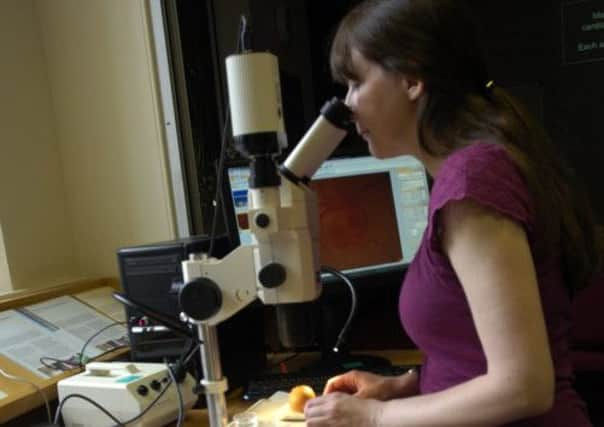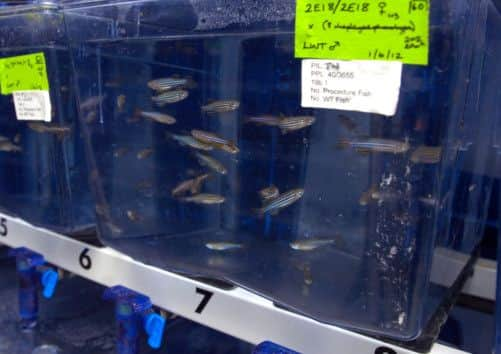Fish, fowl and biomedical genetics... inside a laboratory that saves lives


LOOKING at the tiny zebrafish, not much bigger than your thumb nail, it’s hard to believe that we share many of the same cells with these miniature aquatic creatures.
It’s perhaps even harder to believe that these same tropical fish could help combat human diseases like cancer and epilepsy. But here at the Medical Research Council (MRC) Centre for Developmental and Biomedical Genetics, at Sheffield University, they aren’t the only animals helping scientists gain a better understanding of the building blocks of human biology.
Advertisement
Hide AdAdvertisement
Hide AdCutting-edge studies at the centre on simple animals such as fruit flies and chicks have led to changes in the way we try to tackle and cure a broad range of illnesses and conditions, from cardiovascular and inflammatory diseases to cancer and dementia.


The Sheffield centre is one of the biggest of its kind in the country and one of the few where scientists and clinicians, those who turn scientific knowledge into life-saving medicine, work alongside one another.
As part of the celebrations marking the Medical Research Council’s 100th anniversary, the centre opened its doors to the public so they could meet some of the scientists involved in this pioneering work.
In recent years there have been spectacular advances in biological science, particularly the realisation that on a cellular level we share many similarities with mice, fish and even flies. It is these similarities that are shedding new light on diseases that some people feared we would never properly understand.
Advertisement
Hide AdAdvertisement
Hide AdProfessor Marysia Placzek, the centre’s director, says imaging techniques allow scientists to analyse cells and target those that go wrong to find out why they aren’t working. “We use these animals to better understand what are often complex diseases,” she explains.
“What we’ve established is that the genes in you and the genes in fruit flies, and the proteins in you and the proteins in fruit flies are pretty similar. Something like 60 per cent of the diseased genes in flies are diseased genes in humans. So at a basic level they’re both the same.”
By experimenting in the labs they’re able to gain greater understanding of what triggers many diseases. “What this research is doing is making us realise that so many of the diseases we will encounter are multi-cellular. But if we can identify the early stages we can really hope to push back the aggressive onset of diseases.
“So many of us only go to the doctors when we are in the later stages and if we can begin to highlight what to look for then this could make a big difference,” she says. “If you catch cancer early and go after it you have a good chance of pushing it back and the aim is to do that with other diseases, too.”
Advertisement
Hide AdAdvertisement
Hide AdThe work of Prof Placzek and her colleagues at the university is not only paving the way for the development of new treatments, it’s also allowing them to explore links between different diseases.
“So many drugs out there are used to treat one thing but until recently no one’s thought ‘actually, that’s the same process maybe we could use that drug that’s used to tackle headaches, to tackle cancer’.”
One exciting area of study to emerge recently is regenerative medicine which not that long ago was seen as the stuff of science fiction.
“The idea behind regenerative medicine is to identify where you have stem cells in an adult and work out what’s controlling them in the hope of then being able to bring them on, especially in the elderly and those suffering from disease,” adds Prof Placzek.
Advertisement
Hide AdAdvertisement
Hide Ad“However, these studies are in the early stages. All across the world we’re seeing drug development programmes happening, but regenerative medicine is further away than those.”
She cites a new drug that’s just been approved in the US. “It’s used to treat a type of skin cancer that was previously thought to be completely untreatable and that has grown out of exactly this type of approach.”
By establishing which small animals, fish and insects share similar cells with us scientists and clinicians are able to lay the foundations for pharmaceutical companies to develop new drugs. Prof Placzek says it takes about 20 years for a breakthrough in the lab to be translated into a treatment for patients. “That’s what we’re looking at for drug development programmes. For the regenerative medicine we’re at the beginning of that process,” she says.
“One of my colleagues is using human stem cells to try and grow ear cells and attempt to restore hearing in a gerbil. But I think it’s going to be about 20 years before that’s translated into human benefits.”
Advertisement
Hide AdAdvertisement
Hide AdMany people, though, are uncomfortable with the idea of animal testing, even if it’s done solely to find ways of saving lives. Which is why Prof Placzek and her colleagues want to spell out what they are doing and why.
“It’s so important for us to be able to open our doors and say to people we are using animals, but we’re often using them very non-invasively and the breakthroughs we are making are fundamentally impacting on the development of new drugs.”
And Prof Placzek is in no doubt about the significance of biomedical research. “Biology is the science of the moment, unquestionably, and I think we will start to see a huge revolution as we realise that we can tackle complex diseases through these routes.
Downstairs in another lab, Dr Tanya Whitfield, a reader in development biology, studies fish embryos. Here there are hundreds of small water tanks, each containing fish with a different genetic make up.
Advertisement
Hide AdAdvertisement
Hide AdSome of the scientists are looking at how bones develop and regenerate which could transform the way we treat injuries in the future.
“We’re learning about all sorts of different disease processes,” says Dr Whitfield. “My own particular interest is how the inner ear develops and trying to understand the genetics of deafness and balance disorders.
“Fish have an inner ear and they use if for hearing and balance. So we look for a fish embryo where the ear is not developing properly and we can then identify what gene or mutation is causing that problem and that often gives us a clue into human disease.”
Dr Vincent Cunliffe, a senior lecturer based at the centre, works on epilepsy and for the past couple of years has been using a drug screening technique to try and find compounds that might help to suppress seizures.
Advertisement
Hide AdAdvertisement
Hide Ad“What we learn from the fish is directly translated to humans because of the underlying biological similarities between fish and us,” he says.
“We’ve been able to experiment on existing drugs used for treating other things to see if any of them could be u sed as a new anti-epileptic. We found anti-fungal agents that were used to treat skin diseases that also had an anti-epileptic effect.”
This has the potential to help those people whose lives are blighted by the disease. “Thirty per cent of people with epilepsy don’t respond to any of the existing therapeutic drugs available and their seizures are either treated with surgery or they’re not managed at all. So this gives us the possibility of being able to create new uses for existing drugs which is a fantastic step forward.”
Dr Cunliffe believes this kind of research can make a huge difference to people’s lives in the future. “By using this new approach we have the possibility for a quantum leap in developing new drugs to treat all sorts of diseases.”
Advertisement
Hide AdAdvertisement
Hide AdIn the science world, at least, it seems these really are the days of miracle and wonder.
A CENTURY OF BREAKTHROUGHS
The Medical Research Council was founded founded in 1913 to tackle tuberculosis. However, its remit has expanded over the years and to date, 29 researchers funded by the organisation have won Nobel prizes.
Among the breakthroughs it has funded are:
1933 – discovery of the flu virus
1956 – proof that smoking causes cancer
1984 – DNA fingerprinting invented
1995 – deep brain stimulation treatment for Parkinson’s disease
2000 – human genome sequenced
2007 – discovery that thin people can be dangerously fat on the inside.